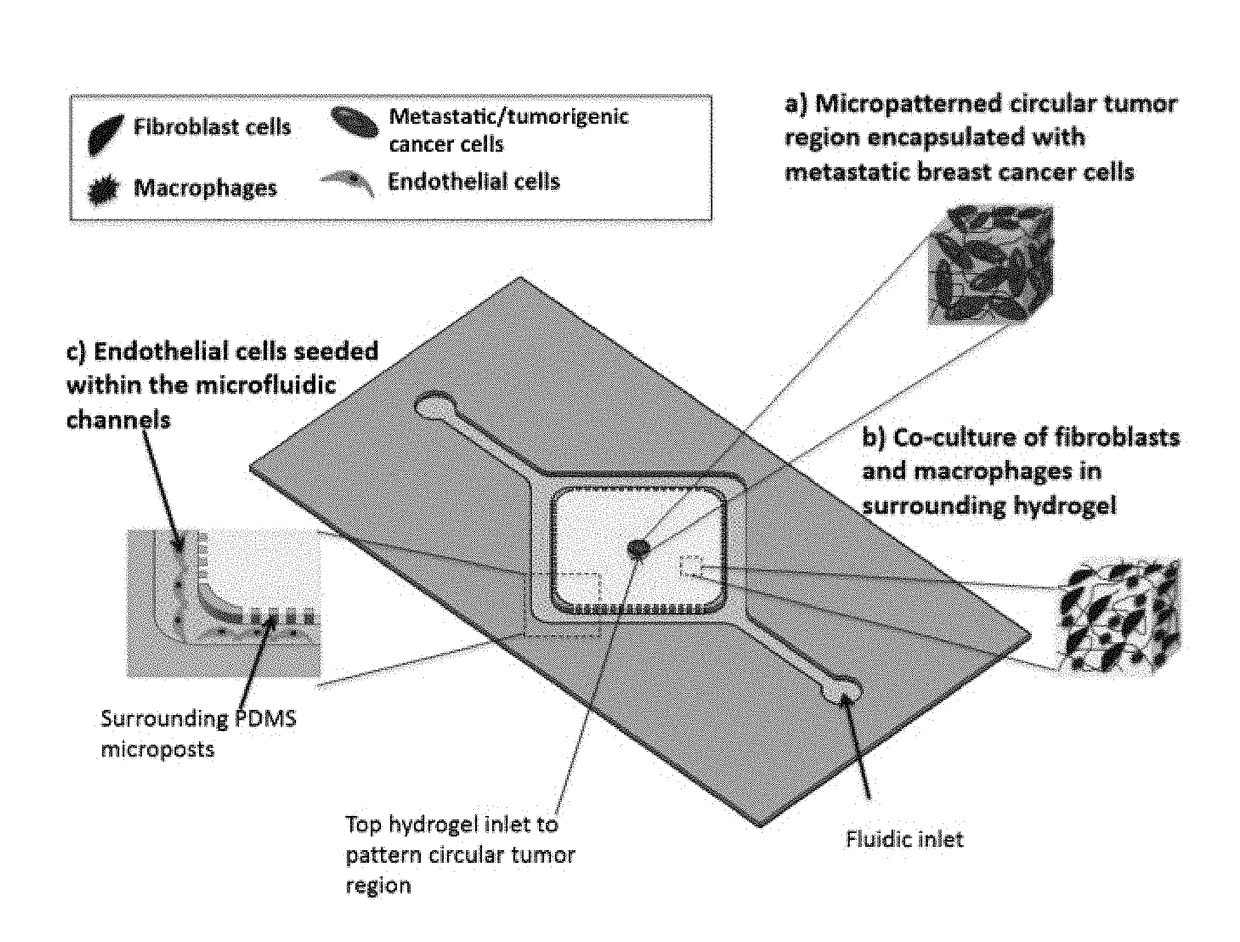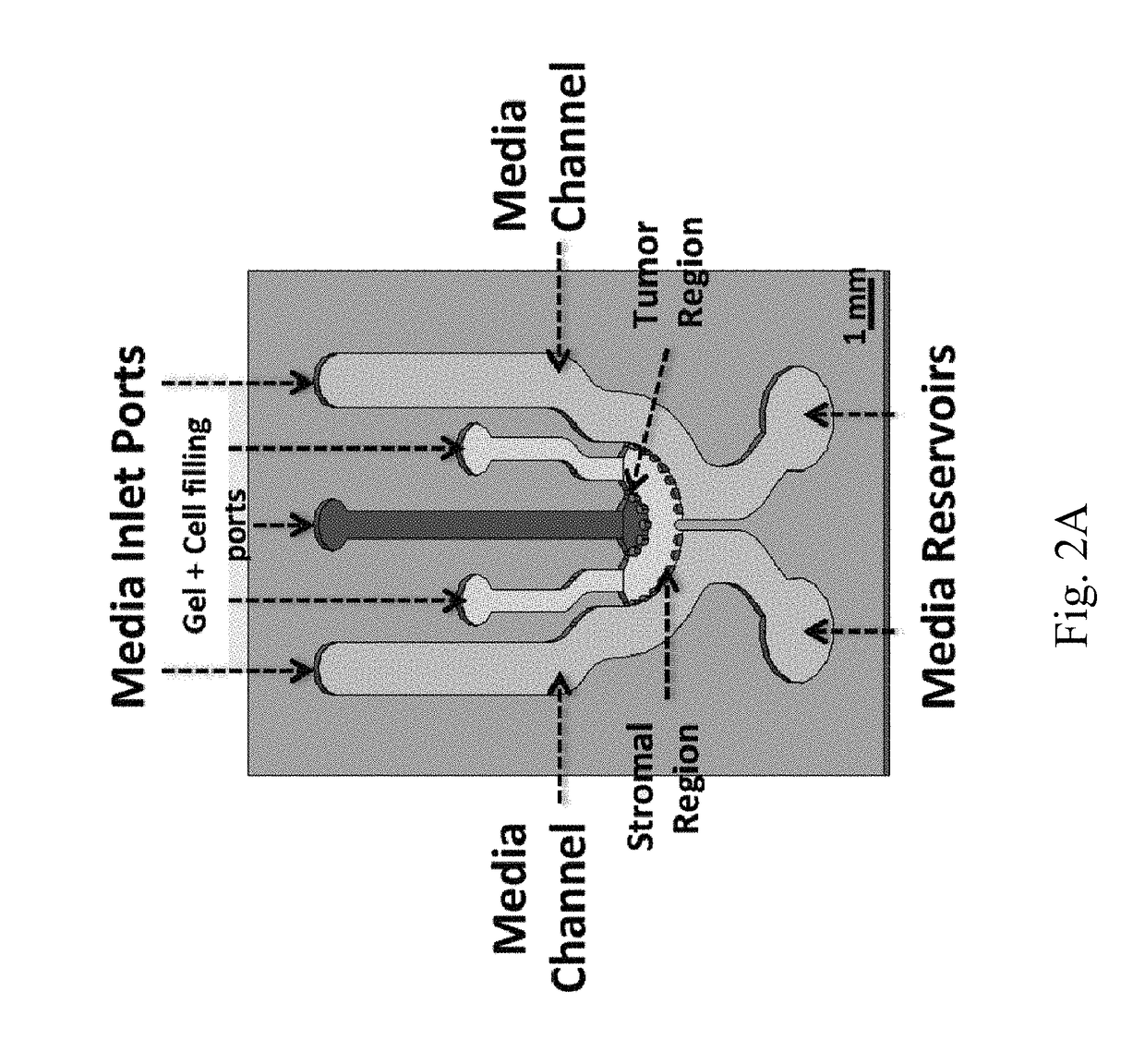Engineering of a Novel Breast Tumor Microenvironment on a Microfluidic Chip
- Summary
- Abstract
- Description
- Claims
- Application Information
AI Technical Summary
Benefits of technology
Problems solved by technology
Method used
Image
Examples
example 1
An Exemplary Microfluidic Device
[0090]In this example, we describe a non-limiting exemplary embodiment of a microfluidic device according to the disclosed invention.
[0091]FIG. 1 shows the features of the exemplary microfluidic device. As shown in FIG. 1, the microfluidic device includes two separate regions of hydrogel constructs, one for the circular tumor construct (neoplastic lesion) encapsulated with metastatic breast cancer cells ((a); center circle), and the second one resembling the surrounding 3D ECM stroma for encapsulation of FBs and macrophages ((b); rectangle surrounding center circle). Two parallel microfluidic channels seeded with ECs are interconnected with the surrounding ECM hydrogel ((c), adjacent to the two long edges of rectangle of (b)) . In particular, the microfluidic channels will be used for seeding of ECs resembling the vascular network ((c)). In addition, the microfluidic channels will be used to introduce anticancer drugs for testing.
Microfluidic Device
[0...
example 2
Production and Use of an Exemplary Microfluidic Device
[0104]In this proof of principal example, we demonstrate that a microfluidic device according to the disclosed invention is capable producing a well-defined tissue architecture, and that it enables high-contrast and real-time imaging for detailed invasion and intravasion studies.
Introduction
[0105]The development of our breast cancer invasion platform has given our laboratory the opportunity to investigate and provide insight to key aspects of the metastatic cascade and tumorigenesis. This study validates our model as breast cancer invasion and demonstrates that our platform is capable of producing a well-defined tissue architecture and enabling high-contrast real-time imaging for detailed invasion and intravasation studies.
Creating a Spatially Organized Cancer Invasion Platform
[0106]First, we developed a CAD design that caters to the native breast tumor architecture (FIG. 2A). It consisted of two distinct region made up of two co...
example 3
Another Exemplary Microfluidic Device
[0111]In this example, we describe additional non-limiting exemplary embodiments of a microfluidic device according to the disclosed invention.
Introduction
[0112]In this newly developed platform, we created a novel microfluidic platform comprised of concentric three-layer cell-laden hydrogels, which allowed for simultaneous observation of vascular network maturation as well as breast cancer cell invasion and intravasation. We demonstrated that highly metastatic MDA-MB-231 disseminated from the primary tumor region and invaded into the adjacent stroma layer, where the presence of a vascular endothelial network in the third layer of the platform drastically increased cancer cell motility and invasion. Most importantly, by day 6 of culture, cancer cells could be visualized intravasating into the vasculature. Additionally, the presence of the invading cancer cells significantly reduced vessel diameter and increased permeability, consistent with previo...
PUM
 Login to View More
Login to View More Abstract
Description
Claims
Application Information
 Login to View More
Login to View More - R&D
- Intellectual Property
- Life Sciences
- Materials
- Tech Scout
- Unparalleled Data Quality
- Higher Quality Content
- 60% Fewer Hallucinations
Browse by: Latest US Patents, China's latest patents, Technical Efficacy Thesaurus, Application Domain, Technology Topic, Popular Technical Reports.
© 2025 PatSnap. All rights reserved.Legal|Privacy policy|Modern Slavery Act Transparency Statement|Sitemap|About US| Contact US: help@patsnap.com



